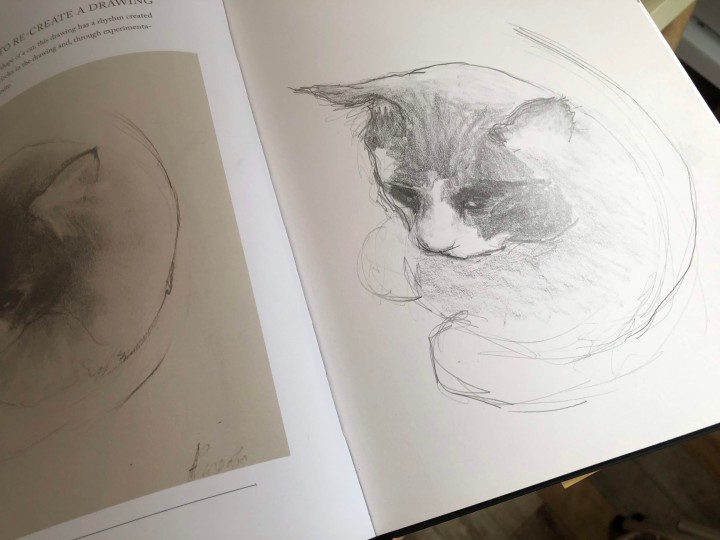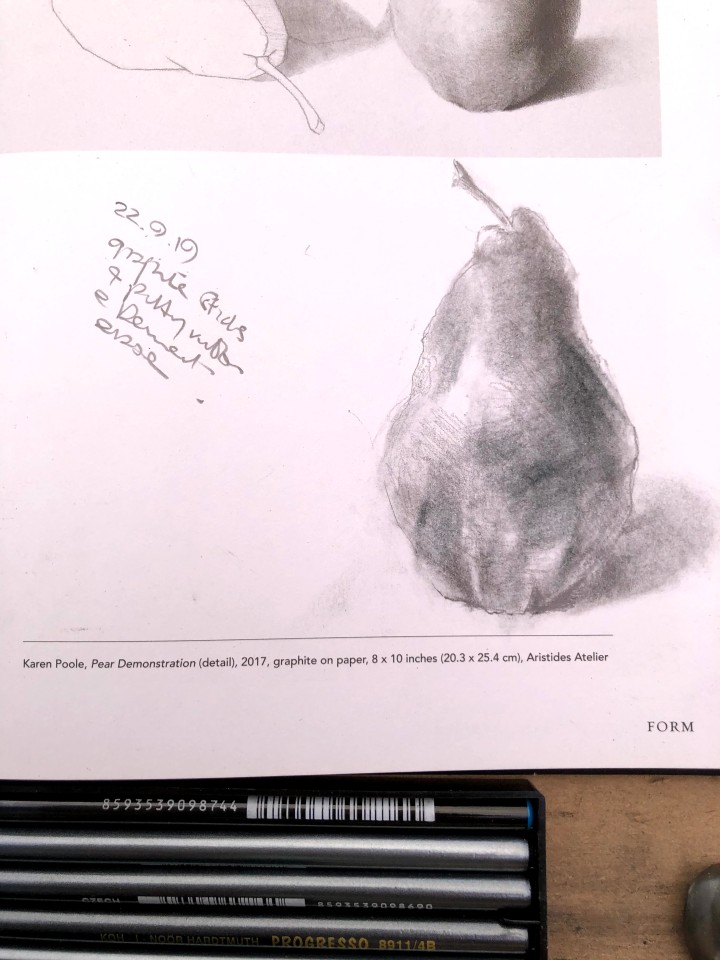This is a work-through of a book on drawing by Juliette Aristides. Copying is a quite a challenge for me, mostly because I’ve never done it, but also because I’m left handed and it didn’t take long to discover that the gestural strokes of right handed artists go completely the opposite way to mine. Every little flick or sweep that comes naturally to one of us is almost impossible to replicate by the other. Still, I’ve triumphed (more or less) over tin-openers so here goes …
All the master images are copyright and so I’m unable to include much, if any, of the original. I used this one [‘Nothing gold Can Stay’ by Julio Reyes, 2016] to get a feel for the partial profile which is one of my nightmares. I used an HB pencil to make the marks and ended up with a couple of attempts (the bottom two) that seem passable.

These are open line drawings to shade with a view to studying the actual rather than the imagined shapes of hands and fingers.

This too is an exercise in shading. The original from which the outlinse come is ‘Man/s Arm Bent’ by Charles Bargue (1866).

The master image here is just called ‘Sketchbook’ and it’s by Adolf von Menzel (1863). It shows a woman reading to a child and is entirely in line, no shading at all.

I labelled this ‘podgy kid with a goat’ but it turns out to be ‘Studies for the Christ Child with a Lamb’ by Leonardo da Vinci, 1503-06. Luckily he will never know. What’s interesting about this is that the orientation suited me, as did the marks, and I realised that da Vinci is reputed to have been at least ambidextrous if not actually left handed.

One of my favourites from whole book. I have cats, and know cats; I’m familiar with the shapes they make and this one could very easily be ‘cat in a fruit bowl’ or ‘strange fruit’. In fact it’s an untitled piece by Anna Egrova, 2013 who used graphite which I’ve only just discovered. I had none at the time and used a 7b pencil plus some judicious putty rubbing.

Another untitled Egrova from 2013, also in graphite while mine is pencil again. I was pleased with the angle of the head and the partial profile, both of which I struggle with.

This still life (by Ovidio Cartagena – Still Life with Lemon 2017) foxed me somewhat. The instructions were to make guide lines around the perimeters of the various elements but in doing that, I lost the sense of the whole. Also I couldn’t identify two of the elements (the packet shape and the ticket shape beneath) but that’s not a bad thing as another instruction is to draw what you see, not what you think you see.

The pineapple was much easier as the master image is a botanical drawing by James Marion Shull (1919) called, unsurprisingly, Pineapple. You will have to trust me that the face I couldn’t help seeing in it once I had finished, is also there in the original!

This is one of the exercises in value (tone). The original is ‘Still Life Demonstration’ by Paul Rosiak (2017). I realised afterwards that I had moved away a little from making value using fine lines and I believe now that this is because it’s hard if not impossible to replicate drawings made with graphite when using pencil strokes. I feel quite happy with this despite having produced what appears to be a half eaten instead of a whole apple.

Much the same applies here – rendering a copy of a graphite drawing using pencil and, to my mind, making this more my own in the process. The original is ‘Study of a Teapot’ 2017, again by Rosiak.

I think we’ve all done these at some stage or another – created volume with shading and tone. Damien Leeds’s ‘Sphere’ 2019, is in charcoal and again I used a 7b pencil.

It was at this point that I took delivery of my first graphite powder. Like herding cats, this stuff gets everywhere and has to be contained. I used paper towel to rub it into the paper, putty rubber to remove (reductive drawing) layers for lighter tones, and charcoal where I wanted some definition. The original is ‘Apple Demonstration’, 2018, by Grace Flott.

Now I was in possession of graphite sticks and I’d watched some tutorial videos on how to use this substance. I have copied the general shape of the original (‘Pear Demonstration’ 2017, by Karen Poole) but there is more of my own style in it, I think.

And here we are at my betes noir – portraits. The original by Elizabeth Beard (2016) is called ‘Aubrey Final’ which suggests the model is male, while mine, in graphite plus Derwent eraser, seems more female. Best bit? That eye!

I’m very fond of this despite again seeming to have re-gendered the model. ‘Jamaal’ by Colleen Barry (2014) is a very self assured young man while my ‘copy’ is clearly a slightly worried-looking woman! Made in graphite, charcoal, white conte, and judicious application of putty and other erasers.

The ink drawing by Irvin Rodriquez – ‘Los Infantes II’, 2016 – could never be replicated in pencil/graphite, not by me anyway. My attempt with the media I have to hand and the paper in the book itself is the best I can manage. It was very difficult though and I have the head angle wrong on two planes – vertical and horizontal – so that my little boy is more upward facing and oriented to the left of the page than the original. He is also less obviously a chubby infant.

Finally for this book, the drawing that I find least successful of the lot and confirmation if that were needed that da Vinci is the Master, my ‘copy’ (it’s nothing like!) of his 1490 ‘Study of a Young Woman’. I have no idea why I found the angle of her head so difficult to replicate; why whatever I tried, her face flattened in the partial profile; how it was that the proportions measured out with a ruler somehow led to a misproportioned image; What happened to her gentle and quiet expression; and how on earth I managed to make her more Greek than Romanesque. I may try to resolve this issue by tracing the original in the book to ‘show’ my brain where all the parts are located.

All the originals can be found in Beginning Drawing Atelier by Juliette Aristides (2019) Monacelli Studio.
The next book on my list is Figure Drawing Atelier, also by Aristides. But first there’s the small matter of an Assignment to finish and submit, and the gathering together of paintings and other items for the Steyning Arts Christmas gig. 30th November, since you ask.
